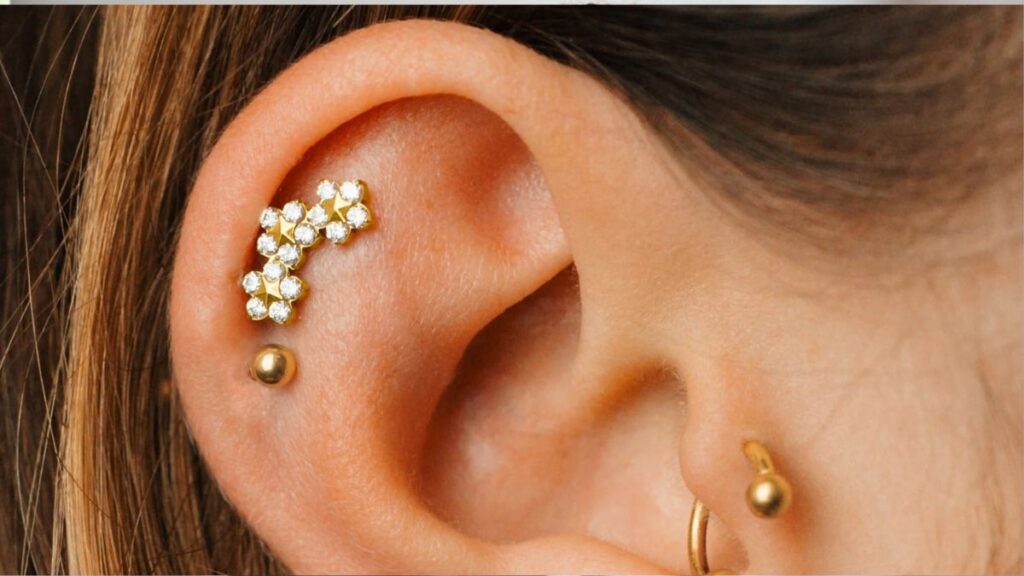When considering a helix piercing, one of the most common concerns for first-timers and experienced piercees alike is the pain. As a piercing enthusiast with extensive experience with various ear piercings, including helix and cartilage piercings, I understand how daunting it can be to anticipate the discomfort of getting a piercing. Whether you’re visiting a professional piercing shop or considering doing it yourself, it’s important to know what to expect. In this article, I’ll explore the pain levels associated with a helix piercing, compare it to other piercings, and offer guidance on aftercare to ensure a smooth healing process.
What is a Helix Piercing?
A helix piercing is an ear piercing located in the outer rim of the ear cartilage. It’s a popular choice for those looking to add a subtle but stylish piercing to their ear. Helix piercings can be done anywhere along the outer cartilage and can even be combined with multiple piercings in a single ear for a trendy, stacked look.
How Painful is a Helix Piercing?
The pain level of a helix piercin’g is often described as moderate. For many people, it’s slightly more painful than a lobe piercing due to the cartilage being pierced rather than the softer lobe tissue. The pain tends to be sharp but quick, and most people report that it lasts for just a few seconds during the piercing process. Afterward, the pain usually subsides, but mild discomfort or soreness can persist for a few hours to a couple of days as your body adjusts.
Compared to other piercings, the helix piercin’g is often described as a more intense experience than, say, a lobe piercing but less painful than some other cartilage piercings, such as the tragus or snug piercings. It’s important to keep in mind that everyone’s pain tolerance is different, so your experience may vary.
How Long Does a Helix Piercing Take to Heal?
The healing process for a helix piercin’g typically takes around 6 to 12 months, depending on how well you care for it and your body’s healing capabilities. Healing cartilage piercings can take longer than soft tissue piercings due to the nature of the tissue and its limited blood flow. During this time, it’s essential to follow proper aftercare guidelines to minimize the risk of complications like infection or prolonged pain.
Helix Piercing vs Cartilage Piercing: Is There a Difference?
You might be wondering how a helix piercin’g compares to other cartilage piercings, such as a tragus piercing or a conch piercing. While both types involve piercing through the ear’s cartilage, the pain level and healing process can differ.
- Tragus Piercing: Often considered more painful than a helix piercin’g, the tragus is located at the small, fleshy part of the ear canal. Because the tissue is denser, it tends to cause more discomfort during the piercing.
- Conch Piercing: This piercing is done through the bowl of the ear and can be more painful than a helix due to its deeper location in the cartilage.
In comparison, the helix piercin’g usually feels more like a sharp pinch and heals more quickly than these more complex cartilage piercings.
And before you go, be sure to read through some of our other helpful posts!
Helix Piercing Recovery: What to Expect
Once you’ve gotten your helix piercin’g, recovery time is essential for ensuring the piercing heals properly. As with any piercing, avoid touching the area with dirty hands to reduce the risk of infection. Here’s what you can expect during the recovery process:
- Initial healing: For the first few weeks, your ear may be sore and swollen. This is normal and can usually be managed with cold compresses and over-the-counter pain relief.
- Long-term healing: After the first few weeks, the piercing may still be tender, but the swelling should decrease. It’s still important to avoid unnecessary irritation by sleeping on the opposite side and cleaning your piercing regularly with saline solution.
Helix Piercing Aftercare
Proper aftercare is critical in ensuring your helix piercin’g heals without issues. Here’s a guide to follow:
- Clean regularly: Use saline solution to clean the piercing once or twice a day. Avoid harsh cleaning products like alcohol or hydrogen peroxide, which can irritate the wound.
- Avoid touching: Only touch your piercing when you’re cleaning it, and always wash your hands beforehand.
- Sleep cautiously: It’s important to avoid putting pressure on the piercing while sleeping. Consider using a travel pillow or sleeping on the opposite side until it’s healed.
Forward Helix Piercing and Double Helix Piercing
If you’re interested in a more unique look, you might want to consider a forward helix piercin’g or a double helix piercing. A forward helix piercin’g is located at the front of the ear, near the head, while a double helix involves two piercings placed one after the other along the outer ear. While the pain level of these piercings is similar to that of a single helix, the healing process can take a little longer due to the increased number of piercings.
Helix Piercing Jewelry Options
When your helix piercin’g has healed, you’ll have a variety of jewelry options to choose from. The most common jewelry for helix piercings includes:
- Hoops: Small, simple hoops can add a classic touch to the helix piercin’g.
- Barbells: Curved or straight barbells are another popular choice and can be used to create a more edgy look.
- Captive Bead Rings: These rings feature a small bead that fits inside the ring, creating a stylish, sophisticated appearance.
Final Thoughts: The Helix Piercing Experience
Getting a helix piercing is a fantastic way to add a stylish touch to your ear, and while the pain level may be a concern, it’s generally manageable for most individuals. The healing process is a journey, but with proper aftercare, you’ll have a beautiful piercing to enjoy for years to come.







